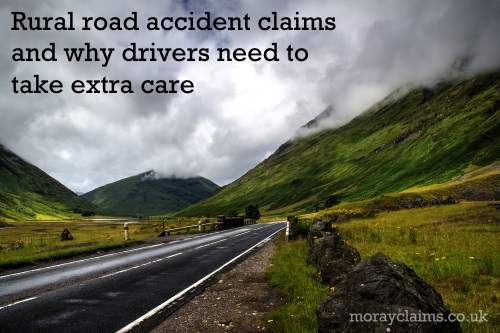
Rural roads account for over 70% of fatal accidents, according to statistics published by RoSPA.
In Scotland, trunk roads, such as the A9 and A96, are maintained by independent companies but more minor roads are the responsibility of local authorities.
Of course, the more minor roads tend to have a greater amount of bends and ups and downs. The increased dangers for drivers are obvious: whether it’s from other traffic, such as slow-moving farm vehicles, or from the state of the road itself.
Roads authorities can rarely be blamed for accidents
A Court of Session decision from June 2012 – arising out of a tragic accident in North-east Scotland – has provided a reminder of the considerable limitations on local authorities’ duties and the emphasis that is placed on the personal responsibility of the individual driver. In these cash-strapped times, the duties the law imposes on local authorities to maintain road markings and signage are not likely to increase in the foreseeable future.
If your driving results in an accident that was not due to the negligence of another driver, it’s unlikely you are going to be able to blame the roads authority.
A tragic accident in Aberdeenshire
In the early evening of 08 May 2006, 27-year-old Ruth MacDonald was driving her Volkswagen Golf on an unclassified road, heading for Inverness. Her mother and aunt were passengers in the car. She was approaching Mill of Brydock, where the unclassified road met the A97 Banff to Aberchirder road. She failed to realise that she had to give way to traffic on the A97 and so drove straight through the crossroads into the path of a transit van. As a result of the collision, she was injured and her mother and aunt were killed.
The driver of the transit van was clearly not at fault but Ruth MacDonald sued Aberdeenshire Council for damages arising from her personal injury as well as for damages for the death of her relatives.
Local authority criticised but not negligent
Her claim was unsuccessful even though the junction was unsatisfactory in a number of respects:
- The road along which Ruth MacDonald was travelling dipped and then had a rising left hand bend just before the junction, where there were a number of buildings close to the road, meaning there was little advance view of the junction.
- There was a “Give Way” sign but it was offset to her left and at an angle.
- There had been double white lines and a “Give Way” triangle painted on the road by the Council to mark the presence of the junction and who had right of way. Unfortunately, these had been rubbed out over time by passing traffic. All that remained were lines at the extreme ends of the mouth of the junction. There were no lines in the centre of the road in the path of her car.
Despite all of these possible criticisms of the Council, the claim failed.
Lord Uist in fact followed the reasoning from another Court of Session case dating from the early 1980s.
In his opinion, Ruth MacDonald’s claim was fundamentally flawed and the Council owed no duty of care to her in the circumstances.
By painting lines at the junction because of the perceived risk of collisions, Aberdeenshire Council, as roads authority, had not somehow imposed on themselves either a retrospective legal duty to paint the lines in the first place or a ‘future’ legal duty to repaint them if they were somehow obliterated.
How we can help
If you have any questions arising from this article or concerning any aspect of our personal injury claims services, please get in touch with us.
You can contact Marie or Peter on 01343 544077 or you can send us a Free Online Enquiry.
All initial enquiries are free of charge and without pressure to take matters further. Get in touch for a chat and see if we can help you.
Image source: Benjamin Sloth via Unsplash.